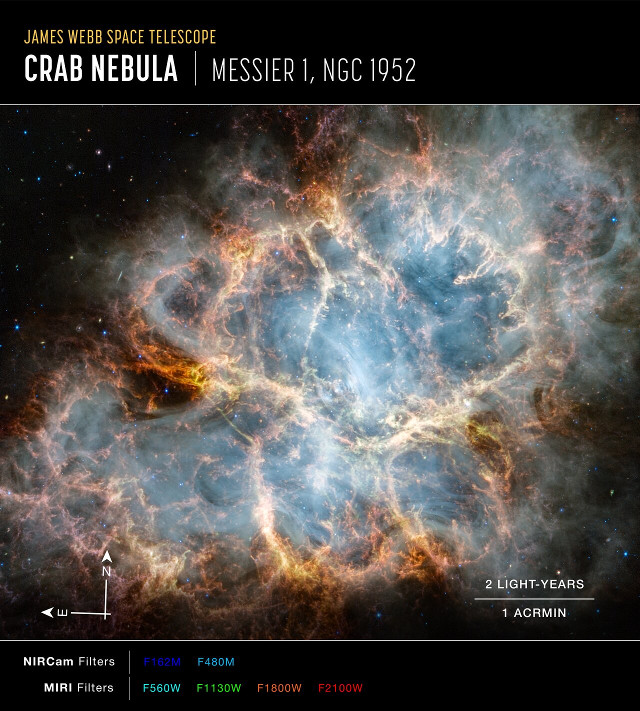
A new image captured by the James Webb Space Telescope depicts the Crab Nebula (Image NASA, ESA, CSA, STScI, T. Temim (Princeton University)), the remnants of the supernova spotted on Earth and recorded in 1054, about 6,500 light-years away from Earth. The observation possibilities at the time were limited, to say the least, compared to today’s, so there are still questions regarding that supernova. The NIRCam and MIRI instruments allowed to obtain infrared details showing the synchrotron radiation inside it, produced by the pulsar at its center that formed from the core of the progenitor star that exploded in 1054.
Discovered independently in 1731 by the English astronomer John Bevis and in 1758 by the French astronomer Charles Messier, the origin of the Crab Nebula was reconstructed identifying it in the supernova recorded in historical documents of 1054, when it was visible to the naked eye. That explosion left a pulsar, a neutron star nicknamed the Crab Pulsar that has a mass about 1.5 times that of the Sun concentrated in a tiny volume.
The instruments built in recent decades are capable of providing observations that astronomers in 1054 couldn’t even imagine. The Crab Nebula is among the supernova remnants studied several times, in one case, even combining five different telescopes to obtain observations in different electromagnetic bands.
The start of the James Webb Space Telescope’s scientific mission made it possible to obtain new infrared observations with its NIRCam (Near-Infrared Camera) and MIRI (Mid-Infrared Instrument) instruments. The result is apparently similar to that obtained in the past at optical frequencies using the Hubble Space Telescope but the details captured by Webb are much superior and offer a lot of interesting information.
The remains of a supernova are composed of materials ejected partly by the progenitor star during its death throes and partly by the supernova. Astronomers are interested in obtaining information on the composition of those materials by exploiting Webb’s sensitivity and spatial resolution, in particular on the quantities of iron and nickel present. That’s valuable information to understand the characteristics of the supernova and the progenitor star.
The total mass of the pulsar and nebula appears insufficient to form a star massive enough to die in a supernova. On the other hand, the formation of the pulsar seems to be conclusive evidence of the explosion of a massive star and not of a white dwarf that stole gas from a companion.
The Crab pulsar, with its powerful magnetic field, accelerates particles to relativistic speeds, generating what is called synchrotron radiation. This phenomenon is visible in the images captured by Webb as a smoky material present in most of the Crab Nebula.
The pulsar also continues to push the nebula’s materials outward and caused the rate of their expansion to accelerate well after the supernova. Perhaps there are materials that are very far from the pulsar because they were already ejected by the progenitor star. They may have cooled to the point of being invisible even to an instrument as sensitive as the James Webb Space Telescope. Astronomers continue to work on reconstructing the history of this supernova and its consequences. Meanwhile, they continue to observe its remnants to discover its secrets, particularly the ones related to the elements it generated, which could end up in a forming star system.

